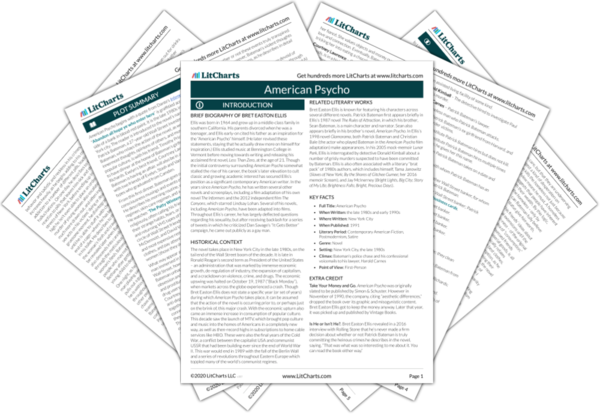Summary
Analysis
It is mid-May, and Bateman is sitting at a table at a bar with McDermott, another banker, Alex Taylor, and three models: Libby, Daisy, and Caron. The women are well-dressed, though Bateman admits he’s only interested in Daisy. He’s had a long day: an anxiety attack paired with a meeting with a lawyer about “some bogus rape charges.” Bateman and McDermott flip a coin to see which one of them will go downstairs to score some cocaine; Taylor is asleep sitting up and the women are all very drunk. A waitress comes over and Bateman barks an order at her, as the girls go on talking about which new furs they want to buy.
Bateman lets the reader know that a large amount of time has passed, though he doesn’t make any effort to fill in the gaps of the months that have been left out. It seems to be business as usual anyways, with Bateman and his friends out for drinks with attractive, not-sober women. Bateman’s fleeting remark of “bogus rape charges” is not to be ignored – it is one of the few instances in the novel where his actions seem to be legitimized by real-world consequences, but it’s still not something he takes seriously.
Themes
Bateman recalls how, earlier at dinner, McDermott asked the women if they could name any of the nine planets: “the moon” and “comet” were among the answers. The girls carry on and on about furs, discussing their favorite animals and designers. Bateman asks if anyone’s ever played around with an Uzi (a gun) but is ignored. Libby and Caron spot someone they know in the distance and rush off, leaving behind Bateman and Daisy, who flirtatiously ask each other mundane questions.
The women they are with are concerned only with material items, which likely explains why they’re hanging around with Bateman and his friends in the first place. Even when Bateman gets one of them alone, the conversation is impersonal and flat; there is no connection other than materiality and superficiality.
Themes
A woman named Francesca suddenly overtakes the entire booth, greeting everyone ecstatically and talking on and on. She introduces her guest, a girl named Alison Poole, to Bateman. Alison insists they’ve met, and Bateman privately remembers that he physically and sexually assaulted her last spring at the Kentucky Derby. Amidst the commotion, McDermott returns, wiping his nose and insisting he couldn’t find any drugs. They all talk on, listening to the jazz music playing, and before much can happen, McDermott has paid the tab and they head out.
Here Bateman is confronted by one of his previous victims. What could be an awkward of confrontational moment for him, however, is not; he mentions the past attack as if he is amused by the coincidence. This new woman, Francesca, is in stark contrast to the other three – Francesca is talkative, intelligent, and interested in those around her. She is unlike many of the characters we’ve met so far.
Themes
Outside the bar, the group are hailing cabs. A homeless woman approaches them and McDermott, clearly high, dances around dangling a dollar in front of her sobbing face. Eventually, just Bateman and Daisy are left; she’s drunk, claiming there are no more cabs and confusing the lightning for a photographer’s flash. Bateman turns around to see in front of him Bethany, an ex-girlfriend of his from Harvard. He is clearly taken aback to see her. They make quick small talk and she heads off, suggesting that they get lunch soon. Bateman and Daisy pile into their cab.
Once more, McDermott demonstrates his lack of care for the needy, and it seems that drugs have helped exaggerate his actions in this instance. It appears Bateman will have no impediments in taking Daisy back to his apartment to do what he wants with her, but he is interrupted by the appearance of Bethany, and it throws him a bit. Clearly she is different from other women in his mind. Likely the connection they had in the past was real and deep, unlike any of Bateman’s connections now.
Themes
Get the entire American Psycho LitChart as a printable PDF.

Back at Bateman’s apartment, he is undressing while Daisy is eating ice cream on his couch. Out of nowhere, she starts to tell him about an ex-boyfriend of hers who beat her up. Bateman is unsure how to respond. She asks if he thinks she’s dumb; he says he doesn’t. Then Bateman tells Daisy that, earlier that day, he saw a young girl begging for money to get a bus out of town, and he beat her up for misspelling a word on the sign she was holding. The two briefly have sex, and then Bateman tells Daisy she should leave. He tells her he’s scared he’s going to do something bad to her, and that he thinks he’s going crazy. She agrees and leaves his apartment.
Bateman’s encounter with Daisy is also unlike any of the ones we’ve seen before. When she tells Bateman about her abusive ex-boyfriend and her insecurities, she becomes a bit more humanized in his eyes, and he subsequently shows signs of remorse for his actions and concerns for her well-being. It’s likely that this is due in part to his run-in with Bethany. Perhaps Daisy talking about her past made him think of his own, and of a time when he had relationships that weren’t solely shallow and disconnected. For a brief moment, we see what a caring, non-violent Bateman might have one day looked like. This experience is very troubling to him.
Themes












